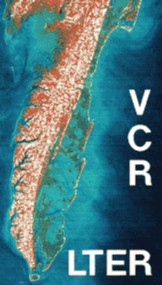
Topographic Mapping of VCR Barrier Islands
Utilizing GPS Technology
|

Charles R. Carlson, VCR/LTER Research Site Manager/
Research Associate, Utah State University;
Raymond D. Dueser, Chair and Department Head,
College of Natural Resources,
Department of Fisheries and Wildlife, Utah State University
|
Abstract
Barrier islands of the Virginia Coast Reserve are noted as highly
dynamic and the
small mammals
which thrive on this 'high-speed real estate' are as dynamic in
nature as the islands they inhabit.
Oryzomys palustris (marsh rice-rat) is an effective disperser over
water and occurs on 21 of the 24 islands whereas
Peromyscus leucopus (white-footed mouse) is less effective and
occurs on only 4 islands (Dueser, et.al.).
During periods of hurricane or storm flooding from rising tides, there
is limited habitat available for small mammals which can give rise to
migration from island to island or island to mainland causing a
dispersal of genes throughout the barrier island ecosystem. In some cases
it can lead to an extinction of a species on an island or in other cases
introduce a new species to an island.
In an effort to determine available habitat during flooding events,
barrier island topography and elevation above Mean Sea Level,
Global Positioning System technology is being employed in the
static and kinematic modes to produce three-dimensional mapping of
Myrtle, Ship Shoal, Smith, and Mockhorn islands of the
Virginia Coast Reserve. Upon completion of GPS data collections, tidal
data will then be incorporated into the mapping scheme which will
provide modelling of barrier island inundation during major storm/flooding
events enabling researchers to determine available habitat during these
periods of 'disturbance.' Utilizing ArcInfo/Arcview, we hope to
provide detailed mapping with the major focus on migration or extinction
of small mammals.
Data collections on Myrtle and Ship Shoal are still in progress and the
first mapping schemes should be available for viewing in early Spring 1996.
As of December 1995, 300+ kinematic baselines have been processed for
mapping purposes on Myrtle Island alone.
Kinematic GPS points are collected on a 10 meter resolution in and around the
permanent small mammal trapping grids located on Myrtle, Ship Shoal, Smith
and Mockhorn islands. Additional points are taken according to island
topography in order to provide accurate mapping information: shorelines,
major dune formations and overwash areas are key data collection areas.
Static points are collected in order to provide additional structure
and integrity to the existing
GPS Network
as well as provide the repeatability of GPS data
collections as the barrier islands
rotate,
move westward and/or roll over. Each static point leaves a permanent benchmark
(some of our key benchmarks are driven to the point of refusal which is
somewhere around 55-60 feet; some of our short-term benchmarks are usually
marked with 1/2 inch rebar driven 20 feet) which is entered into the
VCR/LTER GPS Network. Data collections are accomplished utilizing two Trimble
4000SE units with kinematic capabilities; post-processing is accomplished
with GPSurvey 1.01 and Trimvec Plus.
There are some preliminary 2D and 3D topo maps that are utilized for
'ground-truthing' and working documents which are provided as a
demonstration of mapping with GPS data; only 86 of the
300+ points on Myrtle were included in the topographic maps due to PC
limitations. Those of us who have worked on Myrtle should gain orientation
with respect to the small mammal grid and shoreline locations.
Again, this is only a demonstration utilizing GPS kinematic points;
ArcInfo/ArcView will be utilized in the final mapping stages.
Fig.1...2D Contour with ellipsiodal height labels.
Fig.2...2D Contour without ellipsiodal height labels and contour interval increased two-fold
Fig.3...3D Cartesian Mesh
Aerial photographs of
Myrtle,
Ship Shoal,
Smith, and
Mockhorn
are also available for reference.
Literature Cited:
Loxterman, J.L., Moncrief, N.D., Dueser, R.D., Carlson, C.R., and Pagels,
J.F., 1995. Allozymic Variation in Sympatric, Insular and Mainland Populations
of Two Rodents (Oryzomys palustris and Peromyscus leucopus):
The Effect of Dispersal Capabilities on Genetic Population Structure.
crc7m
VCR/LTER Home Page

